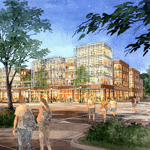Growing
When it decided to increase enrollment five years ago, Washington University in St. Louis (WashU) experienced another type of growth: an escalated need for student housing. Nancy Marshall, project manager of capital projects at WashU, says that the school had already maximized the areas on campus that had the most on-campus housing, so the school had to look elsewhere to accommodate the demand.
The university conducted a study, which lasted more than six months, to determine the best location for new student residences that would be geared toward undergraduate juniors and seniors. The university-owned land in the Delmar Loop area, just northeast of campus, emerged as the best option to attract the right student demographic. “We then worked with an architect on a feasibility study to verify that this site could accommodate the number of units we wanted to construct,” Marshall says.

WashU’s Nancy Marshall stands at Delmar Boulevard and Eastgate Avenue, where several old housing complexes will be torn down to make way for student residences and an underground parking garage. Photo by Joe Angeles
Planning
A key factor was the character of the existing neighborhood. Delmar Loop is a funky, trendy area of St. Louis, which is perfect for near-graduating students. The only problem is that not all of Delmar Loop is funky or trendy. Delmar Boulevard is filled with local shops, restaurants, and bars, but just before Eastgate Avenue, the vibrancy starts to wane. The vibe becomes choppy, less consistent, and eventually fizzles out toward Skinker Boulevard. This section of Delmar has great potential—it just needs more people and businesses. In fact, what it needs is entities like WashU to invest in it and spur development.
WashU won’t be dealing with a clean slate. Several 1970s townhomes and a number of additional multifamily apartment buildings will be demolished to make room for an underground parking garage and five new residential buildings, the construction of which will happen in two phases. In phase one, which started in February and will be complete in July 2014, a total of 166 two- and three-bedroom apartments will be built in four buildings, in addition to roughly 22,000 square feet of ground-floor retail space. Phase two, with a still-to-be-determined start date, will involve construction of the fifth building and extra garage space.
The mixed-use space will include various retail tenants and serve as competition for off-campus housing that is rented by external companies, and it will be managed by the same residential life department that handles all of WashU’s on-campus housing.
But the project is a departure from the university’s other residential options, which were designed to reflect a traditional collegiate Gothic architectural style. “In addition to meeting housing demands for additional students, the product is not like any other we have,” Marshall says. The new residences will feature a more urban look and feel with solid surface countertops and creative lighting, which will also be energy efficient. “These units will be loft-like—funky and fun,” Marshall says. “That played into some of the sustainable aspects too; students who want to live here will know they are signing up for a sustainable lifestyle.”
In a project of this size, information is critical. The university worked with local LEED consultants, architects, and engineers who had worked on previous LEED-certified projects for the university to determine which sustainable elements would be best for the new buildings. “The consultant gathered everybody’s information, digested it, and spit it back to us in a report that said, ‘Here’s where we need to push harder,’” Marshall says. “It’s a very collaborative effort.”

The 4.4-acre mixed-use development will give students more modern and sustainable housing options. The entire project is expected to receive LEED Gold certification.
Greening
Green elements in the new buildings include a wall system with high-performance glazing that will offer strong insulation and solar heat gain properties to the east, south, and west sides of the building. The south-facing wall will have external angled fins to prevent solar heat gain in the summer yet let direct sunlight in during winter months for ‘free’ heat. Each apartment unit will also have demand-based ventilation controls using a mix of keycard relays that will enable and deactivate cooling and heating mechanisms when a resident slides an access card into a lock to enter the unit. To further conserve energy, occupancy sensors will help reduce lighting use. “When the last person leaves, the temperature is set back automatically,” Marshall says. “When the room is empty, the lights go off.”
The site will have rain gardens to slow down water runoff and hold hydration until it can be absorbed into the ground. Three 25-kilowatt photovoltaic solar arrays with a total of 44 solar thermal panels are also scheduled for installation during phase one of the project. Each rooftop will have approximately 102 photovoltaic solar modules. “The maximum number of solar PV panels that will physically fit will be on the roof,” Marshall says.
WashU has a standard, introduced in 2010, that all new large building projects will seek a minimum of LEED Silver certification. Thanks to careful pre-planning, the university anticipates the Delmar Loop project will earn at least Silver status; in fact, as of January 2013, it is targeting LEED Gold.
“The entire team collaborated early on, and because we have completed a lot of sustainable projects, we were very familiar with the LEED scorecard and were able to identify many of the points we would be likely to achieve,” Marshall says. “By challenging ourselves further, we came to include more items that were above what we typically would do.”
The additional sustainable elements assist in reducing energy use and fulfilling the university’s green building standard. But most importantly, they help satisfy students’ desire to live in an environmentally friendly apartment.
“They want to see sustainability in our products, our building, and what we’re doing,” Marshall says. “It is something that the students want, and also something that the university feels very strongly is the right thing to do.”

